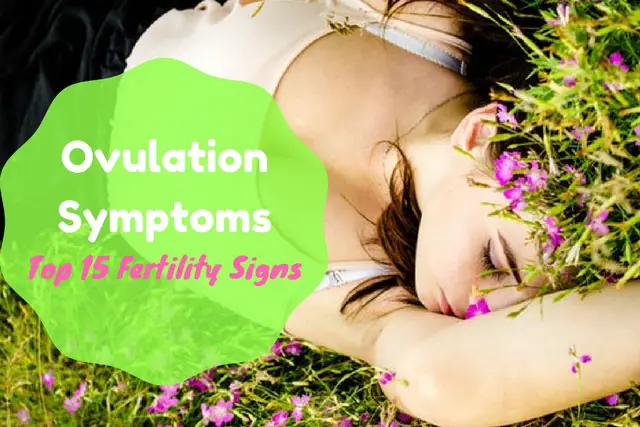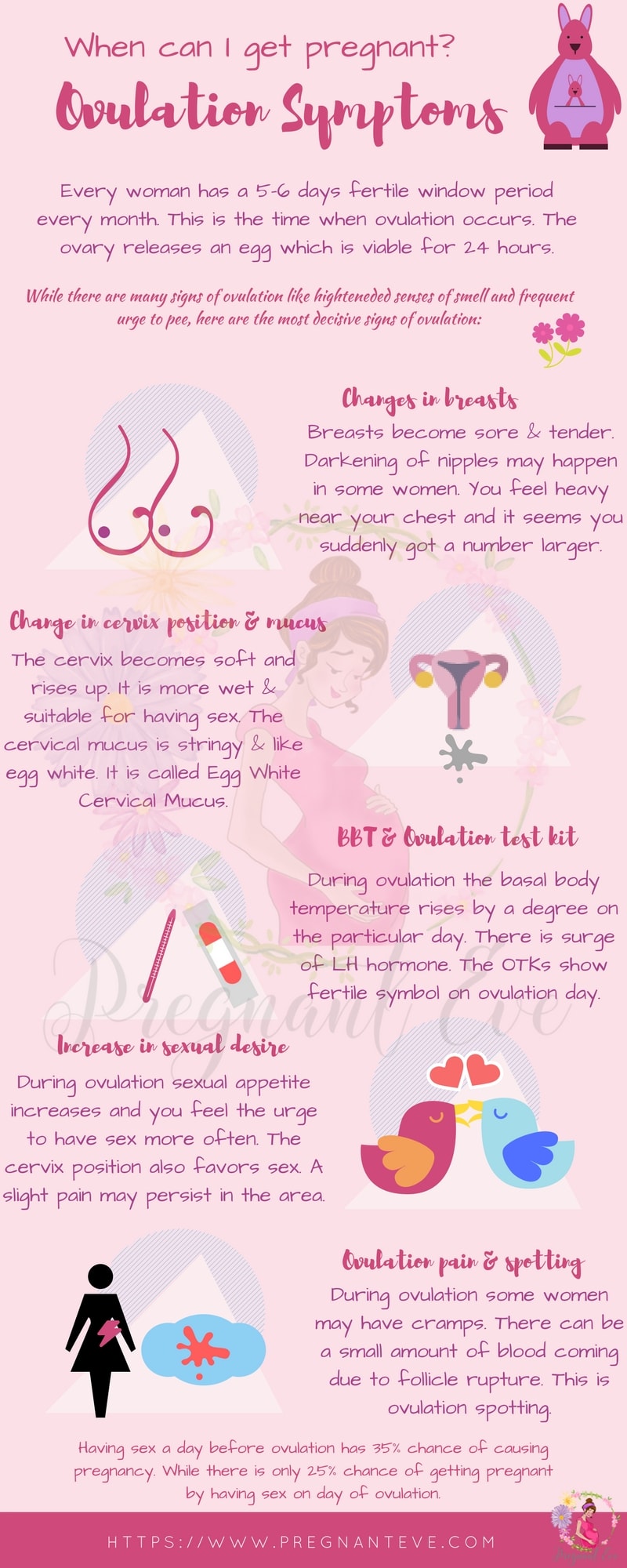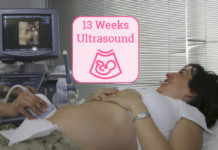Knowing when does ovulation occur is the first step while trying to get pregnant. But unlike period the ovulation symptoms are puzzling.
They are mild and go unnoticed until you actively make an effort to observe them. Observing ovulation symptoms can help you know the most fertile days of the month.
Symptoms of ovulation are distinct for women who have regular menstrual cycles. There are many visible signs of ovulation such as a change in cervical mucus.

What is ovulation?
Ovulation is the release of an egg from either ovary each month. The menstrual cycle is of 4 phases:
1) Menstrual phase
This is the bleeding phase when the uterus lining sheds off. An average 28 days menstrual cycle has this phase for 3-5 days.
The reduction of Luteinizing hormone from the brain is mainly responsible for this.
The decline of this hormone causes the degeneration of egg cyst or corpus lutem.
The progesterone levels fall, and estrogen production also reduces triggering the endometrial lining (uterus lining) to break down.
Elimination of the cells from the lining of the uterus from vagina along with blood is known as Menstrual flow.
2) Proliferative phase or the follicular phase
The menstrual phase ends in the Proliferative phase. It lasts from 6-13 days.
The follicular stimulating hormone causes the releases of estrogen from ovaries inducing rapid multiplication of cells in the uterus and forms the lining. There is also a formation of blood vessels.
3) Ovulatory phase
When does ovulation occur?
This is the 14th day of the cycle. The LH (Luteinizing hormone) attains a peak level and causes rupture of the Graffian follicle.
An ovum or egg releases from the ovary.
When is the fertile window?
The egg lives for 24 hours and sperms can survive for five days, which essentially means a 6-day long fertile window every month.
4) Luteal phase
The egg shell or corpus lutem secretes a significant amount of progesterone hormones. It is for maintaining the endothelial lining for the process of implantation in case pregnancy occurs.
The large amount of progesterone causes a release of watery mucus.
The glands start forming ample watery mucus. If pregnancy doesn’t occur, the corpus lutem degenerates.
In case fertilization occurs on the embryo implants in the uterus.
The 15-day rule says to time your ovulation backwards from next period. The main reason behind this is that menstrual cycle starts from menses and not the proliferative phase.
Most women make this mistake. After the previous period, there is no surety that the next ovulation will time from that period end.
Ovulation is for the new cycle and as a result of ending of previous one. It is best to time your ovulation day from the next expected period.

Pre-ovulation symptoms
Sperm can live in the vagina for 3-5 days. That’s why the fertility window exists from pre-ovulation days.
Pre-ovulation symptoms are ways to know natural fertility days. These pre-ovulation signs help a woman to get pregnant naturally.
Surprisingly many signs of ovulation start before and last till after ovulation. Ovulation is a single step of release of the egg.
The rest of it occurs before ovulation. Many hormones release during the maturation of egg and they cause changes in a woman’s body.
Chances of getting pregnant after intercourse
| Days relative to ovulation | Chances of getting pregnant |
|---|---|
| 6 Days before ovulation | 0% |
| 5 Days before ovulation | 3% |
| 4 Days before ovulation | 5% |
| 3 Days before ovulation | 15% |
| 2 Days before ovulation | 30% |
| 1 Day before ovulation | 35% |
| Ovulation | 25% |
| 1DPO (After 24 hours from ovulation) | 0% |
Ovulation pain symptoms
There are rarely any symptoms of ovulation that cause pain because it is a rapid process.
Some women might experience spotting and cramping. But it will be very mild and bearable.
Most women never feel any cramping during ovulation. Some women feel pain in one side of the abdomen.
The ovaries ovulate one at a time. The ovulation pain is a sign of which ovary ovulated at that time.
If there are cysts in ovaries in case of PCOD patients, then the pain will be significant.
Ovulation day symptoms
Ovulation symptoms are mostly the symptoms that you start seeing before ovulation. The egg survives for 24 hours.
This is why the watery mucus and cervix position change is what you see after ovulation.
The pre-ovulation symptoms and ovulation symptoms happen simultaneously.
The most actionable tip for detecting ovulation is recording basal body temperature.
A common ovulation day sign is the rise of basal body temperature. Your basal body temperature is when you are completely at rest.
When you want to track ovulation you can keep a record of BBT and the day it rises will be ovulation day.
A rise of basal body temperature is the most reliable ovulation symptom.
The saliva develops a ferning pattern like snowflakes.
Post ovulation symptoms
Signs and symptoms after ovulation include excessive watery mucus. The high levels of progesterone cause a woman glow, after ovulation.
You may see spotting randomly after ovulation. Your cervix will SHOW which is a short form for Soft, High, Open and Wet.
Post ovulation symptoms may continue if pregnancy occurs.
In the other case, the woman prepares to enter the menstrual phase. The luteal phase is critical for regular menstrual cycle.
If a woman has a short luteal phase, then she will not be able to have enough lining for pregnancy. She is prone to miscarriages.

Signs and symptoms of ovulation: Top 15 fertility signs
1) Change in cervical mucus
The cervical mucus during ovulation becomes stretchy and stringy. You can easily use your fingers to swipe and see the consistency of cervical mucus.
Before ovulation the cervical mucus is very minimal. After ovulation gradually it becomes thick and gooey.
Post ovulation cervical mucus secretion reduces and leads to dryness.
The main reason for cervical mucus changes is for effective sex.
Progesterone secretion by corpus luteum increases the amount of cervical mucus during and after ovulation.
2) Basal body temperature rise
On the day of ovulation the basal body temperature rises by ½ degree.
You can record this by using a simple thermometer. Make sure you don’t get out of your bed when you are recording BBT.
A rise in BBT on day of ovulation is because of LH surge.
The LH hormone shoots and has a peak on 14th day of menstrual cycle.
3) LH levels in urine
The Luteinizing hormone is responsible for ovulation. It starts coming in urine on the day of ovulation.
You can detect LH in urine using OPK (ovulation predictor kits). They are over the counter tests and can tell your fertility days.
Even if you have an irregular menstrual cycle you can take ovulation tests.
Ovulation calculators are online resources for detecting ovulation.
4) Sexual appetite increases
During ovulation sexual appetite increases and you feel the urge to have sex more often.
You will have more and more mucus coming when you are aroused. The cervix position also favors sex.
A slight pain may persist in the area.
5) Cervix position changes
The cervix becomes soft and rises up during ovulation. It is more wet and suitable for having sex.
You can feel the two soft lips near your vagina on the day of ovulation.
6) Ovary pain
Some women may have ovary pain during ovulation. This can be because of multiple reasons or just normal.
If a woman has PCOD then her ovaries will pain during ovulation. Later the women suffering from PCOS or PCOD doesn’t ovulate.
The cysts block the ovary paths and don’t allow the eggs to mature.
7) Saliva ferning
Saliva ferning pattern is generally visible by using a high quality microscope.
During regular days your saliva components arrange randomly when spread on a glass slide.
On the day of ovulation, they will form crisscross patterns on a glass slide. You can see this only using a microscope.
8) Sensitivity of sense organs increases
During ovulation all your sense organs become more sensitive. You are able to smell anything from far and your skin glows.
All this is because of the shoot of LH levels.
9) Bloating
You might notice that your jeans are a little tight mid-cycle. Bloating happens during ovulation because the tissues prepare for implantation and other post-fertilization events. It doesn’t last for long.
10) Tender Breasts and relaxed areola
Breasts become soft and may pain a little.
Darkening of nipples may happen but you can feel the swelling. It is visible and you don’t have to press them to feel the tenderness.
You feel heavy near your chest and might experience pain in nipples.
11) Heavy headedness
Due to the different hormones in your body you may feel that your head is heavy.
Dizziness may occur because of draining of energy.
12) Nausea
Nausea is a symptom that signals all reproductive events. During ovulation some women may complaint of nausea.
This will be inexplicable and mild. The nausea might be just for few hours during ovulation.
13) Feeling sleepy and fatigued
You’d feel sleepy and less interested in work. Ovulation is an energy-requiring process and leads to fatigue.
14) Spotting
Some women may have spotting during ovulation. This will be the mildest form of spotting.
It can be that you see a discharge when you pee and nothing more.
You will not need a liner, and if you do, then it is irregular bleeding and no sign of ovulation.
15) Glowing skin and shinier hair
The rising progesterone levels cause a pinkish glow and soft shiny hair. Nature’s ways of trying to make you guys have a new member in the family.
7 days past ovulation symptoms
After 7 days from ovulation you begin PMSing. It is a sign that pregnancy did not occur.
The body gradually loses the fertility temporarily. The cervical discharge becomes less and gooey.
The cervix hardens and the glow and all signs go.
If you conceive, then implantation bleeding may occur. You may or may not have implantation cramping.
Placenta formation will begin. The progesterone will go on rising, and you might have worse mood swings.
After few days your urine will have another hormone that is hCG. Now you will have to look for pregnancy symptoms and pregnancy test kits.










hey i have just turned 18 and i had intercourse with my Bf last night. I don’t understand ovulation. Can you tell me when do women ovulate?
Women ovulate every month around the 14th day of a normal 28 days cycle. It is the release of egg from either ovary which makes her prone to pregnancy for the next 24 hours.
My discharge is thick..is this one of the signs of ovulation?
Thick discharge is sign that you are past ovulation. Egg white mucus is sign of ovulation which is stringy.
My discarge is nonstretchy,I am not getting pregnant ….I don’t understand
Egg white string mucus a little stretchy is sign of fertility. Non stringy mucus doesn’t indicate ovulation. You must have sex when the mucus stretches. If you’re experiencing the same quality of mucus the entire month, your hormones are not tuned. Consult a Gynecologist for hormone shots.
can ovulation starts immediately after your menses end, can one have her menses twice in a month like the early week and the later week
Hi, You can get answers to your questions from experts here: https://trk.justanswer.com/SHPU